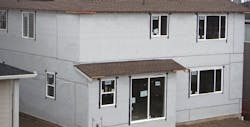When water gets behind exterior cladding—as it inevitably will—it should always encounter a weather-resistive barrier to protect the structure from moisture damage. For many new homes, housewrap serves as this last line of defense. It’s crucial, then, to fully understand the performance differences between housewraps and to use the right one for the job ... or suffer expensive consequences.
What Are the Different Types of Housewrap?
Most synthetic housewraps are made from polyolefin, a common class of plastic, but in two fundamentally different ways:
- A woven variety uses long threads running the length and width of the wrap, resembling cheesecloth.
- A nonwoven type uses shorter fibers set in a random pattern, much like OSB panels.
Of the two types, nonwoven wraps do a superior job reducing the chance of moisture problems, and the extra $200 or so cost premium for the average house is cheap insurance against callbacks and more serious issues.
Woven wraps tend to rip or tear more readily than nonwoven wraps. Like a run in a nylon stocking, a snag in woven housewrap can quickly grow, especially when exposed to wind. This tendency is especially critical when wraps are installed by hurried laborers and remain exposed to the elements for weeks.
By contrast, a nonwoven wrap’s random pattern of fibers makes it stronger in application; incidental punctures won’t run and are easily patched with flashing tape. Resilience during installation and against the elements is a crucial factor, but a bigger issue is the wrap’s permeability.
Exactly how nonwoven wraps are made to be permeable is a closely guarded secret, but I do know they’re engineered so only water vapor (not liquid or bulk water, such as rain or snowmelt) passes through the material, enabling incidental moisture to dry out behind the cladding—the exact quality you want in a housewrap.
For the same reason, woven housewraps are typically made with small perforations across the surface, though not small enough to block bulk water. “You need holes big enough to let golf balls through but small enough to block basketballs,” says Joe Lstiburek of Building Science Corp., in Westford, Mass., who has studied the issue. “But suppliers are punching holes the size of weather balloons.”
The consequences of a woven wrap’s permeability depend on climate. Where walls can more easily dry out after getting wet from occasional rain, such as in the desert Southwest, a perforated woven wrap is an adequate solution. Everywhere else, you’re asking for trouble; in fact, I see more perforated woven housewraps in the rainy Southeast than anywhere.
My advice for those wetter/humid climates? Negotiate the best price for a nonwoven, non-perforated, vapor-permeable housewrap, which leading suppliers offer.
Siding Type and Housewrap Selection
Another consideration: Most housewraps have a smooth surface, but some woven wraps have a three-dimensional texture that provides a slight watershed layer behind the exterior finish. Which one to use depends on that finish material.
For example, loose-fitting sidings, such as vinyl, in essence create their own watershed, so a flat wrap is adequate. But more rigid fiber-cement or engineered wood lap sidings can cause a dam at the top of each course, trapping incidental water. For those claddings, a three-dimnensional woven wrap earns its keep, even at a slight cost premium.
Whatever wrap is right for you, it must be installed with at least 6-inch horizontal laps and 12-inch vertical laps. Layer all flashing components in shingle fashion and tape every seam, and always use button-cap fasteners. Remember: Water management details and materials are never the place to cut corners or cost.
Graham Davis is a building performance specialist on the PERFORM Builder Solutions team at IBACOS.
- Access a PDF of this article in Pro Builder's December 2018 digital edition

